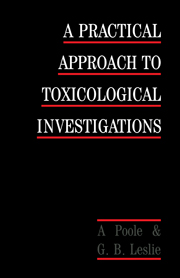Book contents
- Frontmatter
- Contents
- Foreword
- Preface
- List of abbreviations
- 1 Introduction
- 2 Regulatory requirements
- 3 Animals: sources, selection, husbandry
- 4 Standard studies in animals
- 5 Measurements and observations made in living animals
- 6 Terminal studies
- 7 Specialised routes of exposure
- 8 Reproductive toxicology
- 9 Genotoxicity
- Appendix 1 Toxicology data requirements for clinical trial approval and registration of new drugs
- Appendix 2 Countries and addresses of regulatory agencies
- Index
7 - Specialised routes of exposure
Published online by Cambridge University Press: 04 August 2010
- Frontmatter
- Contents
- Foreword
- Preface
- List of abbreviations
- 1 Introduction
- 2 Regulatory requirements
- 3 Animals: sources, selection, husbandry
- 4 Standard studies in animals
- 5 Measurements and observations made in living animals
- 6 Terminal studies
- 7 Specialised routes of exposure
- 8 Reproductive toxicology
- 9 Genotoxicity
- Appendix 1 Toxicology data requirements for clinical trial approval and registration of new drugs
- Appendix 2 Countries and addresses of regulatory agencies
- Index
Summary
Regulatory authorities generally require, as a valid predictive toxicological investigation of a new medicine, that toxicity studies are conducted using the route of administration which is to be used clinically. This requirement can, from time to time, prove problematic for the toxicologist. For instance, while it is usually possible to dose compounds by the proposed route of clinical administration, it is often impossible, both in terms of quantity and duration, to treat animals with large multiples of the human dosage. For example, there are physical and humane limitations on the maximum volumes that can be administered intravenously, intramuscularly, subcutaneously, intraperitoneally or into the rectum, vagina, eyes, etc. Increasing drug concentrations to multiples of the human dose may be similarly restricted because of problems with solubility pH, tonicity, etc. For some routes of administration it may therefore be necessary to achieve the overall objective of predicting human risk by somewhat indirect means. For example, to assess the systemic toxicity of a topically applied compound, it may be possible to measure the maximum drug blood levels achieved after local application and then, for longer term studies, use a second route of administration with doses giving equivalent, or even higher, systemic exposure than that achieved by the local route. Thus, for a compound which might be given clinically intramuscularly, intravenously, intraperitoneally or subcutaneously it would not be technically possible, or indeed useful, to conduct long term toxicity studies by these routes.
- Type
- Chapter
- Information
- A Practical Approach to Toxicological Investigations , pp. 101 - 117Publisher: Cambridge University PressPrint publication year: 1989



